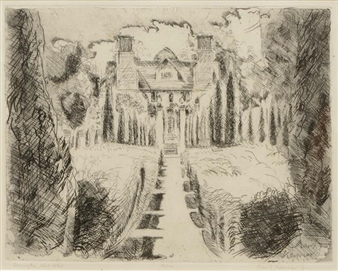Lady Ottoline Morrell - Muses & the Beau Monde
- Lilium

- Mar 17, 2021
- 4 min read
Updated: May 5, 2025

Lady Ottoline Violet Anne Morrell, born 16 June 1873, was an English aristocrat and society hostess. Her patronage was influential in artistic and intellectual circles, where she befriended writers including Aldous Huxley, Siegfried Sassoon, T. S. Eliot and D. H. Lawrence, and artists including Mark Gertler, Dora Carrington and Gilbert Spencer.
Born Ottoline Violet Anne Cavendish-Bentinck, she was the daughter of Lieutenant-General Arthur Cavendish-Bentinck and his second wife, the former Augusta Browne. Through her father, Arthur, she was a first cousin once removed of Queen Elizabeth the Queen Mother, and a first cousin twice removed of Queen Elizabeth II, both of whom descended from Arthur's brother Rev. Charles William Frederick Cavendish-Bentinck.

Ottoline was granted the rank of a daughter of a duke with the courtesy title of "Lady" when her half-brother William succeeded to the Dukedom of Portland in 1879, at which time the family moved into Welbeck Abbey in Nottinghamshire. In 1899, Ottoline began studying political economy and Roman history as an out-student at Somerville College, Oxford.
Ottoline was known to have had many lovers until February 1902, when she married the MP Philip Morrell, with whom she shared a passion for art and a strong interest in Liberal politics. They had what would now be known as an open marriage for the rest of their lives.
Philip's extramarital affairs produced several children who were cared for by his wife, who also struggled to conceal evidence of his mental instability. The Morrells themselves had two children (twins): a son, Hugh, who died in infancy; and a daughter, Julian, whose first marriage was to Victor Goodman and second marriage was to Igor Vinogradoff.
Her circle of friends included many authors, artists, sculptors and poets. Her work as a patron was enduring and influential, notably in her contribution to the Contemporary Art Society during its early years.
The Morrells maintained a townhouse in Bedford Square in Bloomsbury and also owned a country house at Peppard, near Henley on Thames. Selling the house at Peppard in 1911, they subsequently bought and restored Garsington Manor near Oxford. Ottoline delighted in opening both as havens for like-minded people. 44 Bedford Square served as her London salon, while Garsington provided a convenient retreat, near enough to London for many of their friends to join them for weekends.
She took a keen interest in the work of young contemporary artists, such as Stanley Spencer, and she was particularly close to Mark Gertler and Dora Carrington, who were regular visitors to Garsington during the war. Gilbert Spencer lived for a while in a house on the Garsington estate. Ottoline was an prolific amateur photographer, photographing her circle and creating photo albums that are now in the care of the National Portrait Gallery.
During World War I, the Morrells were pacifists. They invited conscientious objectors such as Duncan Grant, Clive Bell, and Lytton Strachey to take refuge at Garsington. Siegfried Sassoon, recuperating there after an injury, was encouraged to go absent without leave as a protest against the war.
The hospitality offered by the Morrells was such that most of their guests had no suspicion that they were in financial difficulties. Many of them assumed that Ottoline was a wealthy woman. This was far from being the case and during 1927, the Morrells were compelled to sell the manor house and its estate, and move to more modest quarters in Gower Street, London. In 1928 she was diagnosed with cancer, which resulted in a long hospitalisation.
Later, Ottoline remained a regular host to the adherents of the Bloomsbury Group, in particular Virginia Woolf, and to many other artists and authors, who included W. B. Yeats, L. P. Hartley, and T. S. Eliot, and maintained an enduring friendship with Welsh painter Augustus John. She was an influential patron to many of them, and a valued friend, who nevertheless attracted understandable mockery, due to her combination of eccentric attire with an aristocratic manner, extreme shyness and a deep religious faith that set her apart from her times.
Her work as a decorator, colourist, and garden designer remains undervalued, but it was for her great gift for friendship that she was mourned when she died in April 1938. She died from an experimental drug given by a doctor. The novelist Henry Green wrote to Philip Morrell of:
"her love for all things true and beautiful which she had more than anyone...no one can ever know the immeasurable good she did."

Ottoline wrote two volumes of memoirs, but these were edited and revised after her death, losing a little of their charm and much of their intimate detail in the process. Perhaps Ottoline's most interesting literary legacy is the wealth of representations of her that appear in 20th-century literature. She inspired characters by Aldous Huxley, D.H. Lawrence and more.
Non-literary portraits are also part of this interesting legacy, for example, as seen in the artistic photographs of her by Cecil Beaton. There are portraits by Henry Lamb, Duncan Grant, Augustus John, and others. Carolyn Heilbrun edited Lady Ottoline's Album (1976), a collection of the snapshots and portraits of Morrell and of her famous contemporaries, mostly taken by Morrell herself.
Reading Recommendations & Content Considerations
A Study in Friendship Snapshots & Portraits
1873-1915 Introduction by Lord David Cecil






























































































































































































































































Comments